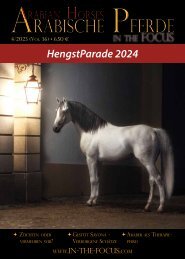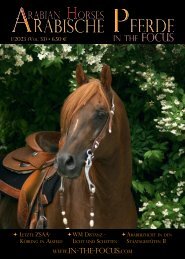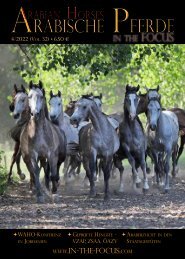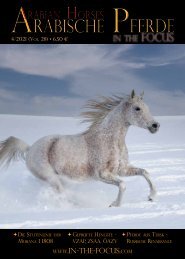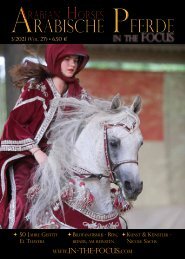Arabische Pferde IN THE FOCUS Nr. 1/2020 (Vol. 21) - Preview
Die Zeitschrift für Freunde und Züchter arabischer Pferde
Die Zeitschrift für Freunde und Züchter arabischer Pferde
Sie wollen auch ein ePaper? Erhöhen Sie die Reichweite Ihrer Titel.
YUMPU macht aus Druck-PDFs automatisch weboptimierte ePaper, die Google liebt.
Gidran XXVII-48 (Kötörö) - the naming and<br />
numbering follows the old Austro-Hungarian<br />
system. -<br />
Gidran XXVII-48 (Kötörö) - die Namensgebung<br />
und die Nummern folgen dem alten<br />
österreichisch-ungarischen System.<br />
Difficult War Times<br />
Being bred only in one stud, the breed was<br />
never very numerous. But when Romania invaded<br />
Hungary in 1920 (Hungarian–Romanian<br />
War), they took 74 mares as loot. This<br />
left Hungary with only 13 mares, and the<br />
breed close to extinction. Between the two<br />
world wars, stallions of the Kisber breed (a<br />
half-bred horse), such as Maxim V and Kozma<br />
III, were used as well as Shagya Arabian<br />
stallions, such as Mersuch III *1918, Siglavy<br />
VI *1922 and Gazal III *1912. This choice<br />
was followed with good results and the anglo-arab<br />
character of the breed was consolidated.<br />
However, when the Romanian army took<br />
those 74 mares as loot, some of them were<br />
brought to Radautz Stud, where they started<br />
to breed the Gidrán horses with 55 mares.<br />
These horses were bred for some time<br />
as pure Gidrans, but in 1989 their numbers<br />
were reduced and the horses sold and lost<br />
for registered breeding. Until recently, Radautz<br />
still had some Gidran stallions at stud,<br />
for example Razbeg and his offspring, but<br />
today, they are all gone. They were of a more<br />
heavy type than the Gidrans at Mezöhegyes.<br />
With careful breeding the number of mares<br />
in Mezöhegyes was raised, and by 1944 the<br />
stud numbered 90 mares again. But the war<br />
hit the breed again, and numbers were down<br />
to only 28 mares, regained from Bergstetten<br />
in Germany, to where they were evacuated,<br />
which then were returned to Mezőhegyes. In<br />
1957, the stud was moved from Mezőhegyes<br />
to Dalmand. The breed was revived in 1975<br />
when the purebred population consisted of<br />
3 stallions and 16 mares. A new stud was<br />
established in Borodpuszta and Gidran IV,<br />
a purebred Gidran stallion, whose bloodline<br />
plays a decisive role in today's herds, was<br />
imported from Romania.<br />
Considering the close co-operation and<br />
swapping horses among the Austro-Hungarian<br />
Studs in the 19th century, it is not surprising<br />
that Shagya-Arabians and Gidrans share<br />
some common ancestors. And actually, there<br />
is a Gidran strain in the Shagya-Arabian,<br />
which was bred in Radautz and there are Gidrans<br />
with Siglavy Bagdady in their pedigree<br />
even today.<br />
The Return of the Gidrans<br />
In Hungary, the Gidran returned in 2018 after<br />
six decades to the National Stud of Mezöhegyes<br />
and thus came back to the cradle<br />
of this breed. Alltogether 96 horses were<br />
re-purchased to found the breeding stock for<br />
a new venture.<br />
At present, the stallion Déva Gidran-13 (Riadó)<br />
*1993 is used, whose sire was Deva xx.<br />
This new English Thoroughbred influence<br />
is to improve nobility and elegance and to<br />
maintain the suitability for sports. Riadó<br />
was a successful sports horse with a bery<br />
good training and working ability, as well as<br />
winner of the most important breed show in<br />
2009. Gidrans are especially good in eventing,<br />
where they achieve excellent results also<br />
at international level. One example, the mare<br />
Gidran Sohaj *1997 has been added to the<br />
broodmare band at Mezöhegyes. She placed<br />
18th at the World Young Horse Championships<br />
2004 in Eventing under William Fox-Pitt<br />
(GB).<br />
An Endangered Breed<br />
The Gidran is a strong and noble breed in<br />
every respect, and represents a correct, elegant<br />
half-blood horse. The breed is characterized<br />
by ground-covering movements and<br />
dry, strong limbs. The large eyes and the wide<br />
forehead, the play of the ears and the fine<br />
coat indicate the Anglo-Arabian ancestors.<br />
His size is aimed to be 160-165 cm.<br />
Because of its low number, the breed is one<br />
of the endangered populations (200 mares in<br />
Hungary, 300 worldwide), but could always<br />
give internationally successful sport horses<br />
for sport. As a traditional gene reservoir, it<br />
is both culturally and genetically valuable in<br />
the Hungarian animal breeding. Some of the<br />
female lines have a breeding history as long<br />
as 20-25 generations.<br />
Gudrun Waiditschka<br />
Zucht<br />
Gidran Soháj - she was highly successful in<br />
eventing, here at 22 years as broodmare. -<br />
Die im Sport sehr erfolgreiche Stute Gidran<br />
Soháj im Alter von 22 Jahren als Zuchtstute.<br />
1/<strong>2020</strong> - www.in-the-focus.com<br />
27



